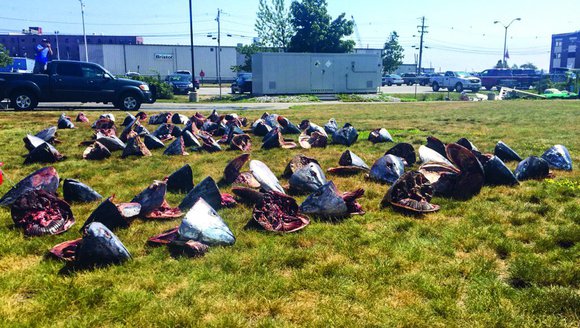Building Demand for Bluefin Tuna
Improving the quality, marketability, and value for U.S. Atlantic bluefin tuna.
The U.S. Atlantic bluefin tuna (ABFT) fishery is strictly regulated, and provides a livelihood for thousands of U.S. commercial fishermen. Unfortunately, fishermen and tuna suppliers struggle to sell this highly regarded fish in domestic markets in part due to negative perceptions about its sustainability. This project aims to train fishermen on best practices to increase the quality and value of tuna being landed, and to engage local restaurants and retailers to update perceptions and increase local purchasing of bluefin tuna.
Project Goals:
- Improve quality handling practices at the vessel level for Atlantic bluefin tuna through cooperative research.
- Implement outreach and education to improve buyer perceptions and build local market demand for Atlantic bluefin tuna.
This project takes a multifaceted approach to addressing the challenges faced by the local bluefin tuna industry. Hands-on training and education of fishermen will improve the quality of tuna being landed, and engagement with restaurants and retailers will update common misconceptions about local bluefin, building local market demand. The combination of these approaches will have a positive impact on the domestic market for local bluefin tuna.


Dr. Walt Golet’s lab will lead cooperative research to test and develop innovative quality handling techniques with fishermen on board their vessels. We will convene fishermen and suppliers for workshops on best practices for quality handling based on existing standards, science-based practices from Japan, and newly developed techniques. This will include trainings for fishermen on handling practices and materials that can be shared with fishermen across the east coast.
The GMRI seafood team hosted two workshops, one in Portland, Maine and one in Boston, Massachusetts, to engage seafood supply chain businesses through networking and education — from fishermen, to suppliers, to restaurants and retailers. These workshops educated participants about the sustainability of the fishery, the bluefin tuna supply chain and marketplace, the stories of fishermen, and the quality of the product, empowering restaurants and retailers to source more local bluefin tuna.
Story
Tuna School: Crash Course on a Local Delicacy
Atlantic bluefin tuna can present some challenges for seafood consumers looking for responsibly harvested options. These highly migratory fish are a complex species to manage, …
Perspectives|Jul 12, 2022
Additionally, the team hosted an event featuring local bluefin at Seafood Expo North America in Boston in March 2023. This is the largest seafood trade show in North America and was an opportunity to educate chefs, retail buyers, and seafood distributors from around the country about the opportunity to source bluefin tuna from the east coast.
Project Team:
-
![]()
Walt Golet
Assistant Professor, UMaine School of Marine Sciences
-
![Staff photo of adam baukus]()
Project Sponsor
This project is generously funded by NOAA's Saltonstall-Kennedy program.
Read More
-
![Tuna School: Crash Course on a Local Delicacy]()
Tuna School: Crash Course on a Local Delicacy
Atlantic bluefin tuna can present some challenges for seafood consumers looking for responsibly harvested options. These highly migratory fish are a complex species to manage, …
Perspectives
-
![Bluefin Tuna Milestone]()
Bluefin Tuna Milestone
Dr. Walt Golet and his Pelagic Fisheries Lab celebrate a significant sampling milestone.
Tidings
-
![Can you eat Maine bluefin tuna with a clear conscience?]()
Can you eat Maine bluefin tuna with a clear conscience?
It's complicated, but here's a hint to tuna lovers: the news is good.
Press Clips
-
![Determining Where Bluefin Tuna Come From | On The Water]()
Determining Where Bluefin Tuna Come From | On The Water
The ear bones of a bluefin tuna provide research scientists with vital information about the origin and age of a fish.
Press Clips





